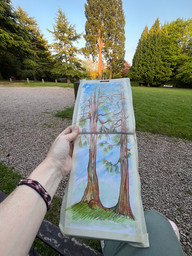My luxury rucksack item is...My Sketchbook
- Louise Earnshaw

- Oct 22
- 3 min read
As an outdoor instructor, I often have to carry a wide range of kit to support myself and others in the mountains, but one item I choose to carry was never listed in my kit training when qualifying as a mountain leader.
A sketchbook and some art materials!
I admit that I didn't always have a sketchbook in my backpack; it was something I would only use if I was sitting in the valley at a 'suitable' location with 'sufficient' time. Over time, it gradually became a part of my expedition life. I vaguely recall having a sketchbook on a few occasions when I began leading Duke of Edinburgh expeditions as a teacher. As an art teacher, I felt it was something I 'ought' to do, but I also remember feeling quite self-conscious about sketching in public.
I clearly recall a trip to London with another art teacher, feeling amazed by her confidence as she carried a sketchbook in her handbag and sketched freely on the train, in the gallery, and on the street. At least in the mountains, people didn't stand and stare.

On my first overseas expedition, I decided to keep a journal and naturally included a few small sketches amidst the writing. This became a habit on every expedition. Initially my journal was a way to express my feelings about the highs and lows of the journey, cultural observations, and adventures through words. Although I still primarily use my journal for this purpose, I now also intentionally set aside time for sketching.
Now I consistently keep a compact, lightweight sketchbook in my backpack, accompanied by a few fine liner pens. On certain days, I bring a wider variety of materials and a larger sketchbook, particularly if I anticipate waiting for some time, such as when I'm waiting for DofE teams or embarking on a personal hike with the intention of both walking and observing.
So why not just take a photograph?
Taking photographs is perfectly fine, and I do it too, but sitting and observing through sketching offers much more than just capturing a beautiful place or object. The more I allow myself to stop looking for the perfect spot and ample time, the more I realise that drawing leads me to observe rather than just glance at my surroundings. I notice colours more vividly, hear nature's sounds, feel the wind, or sense the rain—and yes, you can sketch in the rain! It's not about the final product but the experience of the process.

Have I become braver at drawing in public?
Absolutely, yes! There's always room for improvement, but over the years, I've sketched in cafes, bustling parks, and even in front of the 'Treasury' at Petra in Jordan. Recently, while sitting in front of the lighthouse in Galle, Sri Lanka, drawing, I noticed people filming and taking photos of me. Thankfully, this didn't unsettle me as it used to. It just demonstrates that with practice, anything is achievable and fears can be overcome.
What are my favourite materials to use?
As I mentioned, I always carry a very small, lightweight sketchbook and fineliner pens, allowing me to draw whenever I feel like it without needing a plan. When traveling overseas, I usually bring an lightweight A5 paperback journal to draw and write in due to weight considerations. Depending on the location, I sometimes pack a very small set of watercolour paints or ink-based pencil crayons, but I always include a variety of fineliner pens because I enjoy drawing with them. In recent months, I've started using pastel pencil crayons, which I find delightful as they enable me to capture more colours quickly and complement my fascination with mountain landscapes.
So, I hear you ask how you can get your sketching journey started?
Simplify things! Bring along a small notebook with plain paper or a mini sketchbook in your bag, along with a few favorite drawing tools, such as a pencil, pen, colored pencil, or charcoal pencil. Sketch anything that catches your attention, even if it's just a quick three-minute drawing. The more you practice, the more it will become a habit. If you're seeking additional inspiration and are local to Lincolnshire, consider joining the nature sketching workshops I offer to help you develop simple ideas and enhance your practice.
Happy sketching and please let me know if you have any questions or would like futher guidance.











Comments